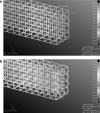Structural Analysis of Voxel-Based Lattices Using 1D Approach
- PMID: 36660292
- PMCID: PMC9831556
- DOI: 10.1089/3dp.2020.0178
Structural Analysis of Voxel-Based Lattices Using 1D Approach
Abstract
Lightweight bioinspired structures are extremely interesting in industrial applications for their known advantages, especially when Additive Manufacturing technologies are used. Lattices are composed of axial elements called ligaments: several unit cells are repeated in three directions to form bodies. However, their inherent structure complexity leads to several problems when lattices need to be designed or numerically simulated. The computational power needed to capture the overall component is extremely high. For this reason, some alternative methodologies called homogenization methods were developed in the literature. However, following these approaches, the designers do not have a local visual overview of the lattice behavior, especially at the ligament level. For this reason, an alternative mono-dimensional (1D) modeling approach, called lattice-to-1D is proposed in this work. This method approximates the ligament element with its beam axis, uses the real material characteristics, and gives the cross-sectional information directly to the solver. Several linear elastic simulations, involving both stretching and bending dominated unit cells, are performed to compare this approach with other alternatives in the literature. The results show a comparable agreement of the 1D simulations compared with homogenization methods for real tridimensional (3D) objects, with a dramatic decrease of computational power needed for a 3D analysis of the whole body.
Keywords: homogenization; lattice structure; periodic structure; structural analysis; voxel.
Copyright 2022, Mary Ann Liebert, Inc., publishers.
Conflict of interest statement
The authors declare no conflict of interest.
Figures










References
-
- Gibson I, Rosen D. Stucker B. Additive Manufacturing Technologies. New York: Springer, 2015.
-
- Bacciaglia A, Ceruti A, Liverani A.. Additive manufacturing challenges and future developments in the next ten years. In: Rizzi C., Andrisano A., Leali F., Gherardini F., Pini F., Vergnano A. (eds). Design Tools and Methods in Industrial Engineering. ADM 2019. Lecture Notes in Mechanical Engineering. Springer, Cham, Switzerland: Springer International Publishing, 2020; pp.891–902.
-
- Gao W, Zhang Y, Ramanujan D, et al. . The status, challenges, and future of additive manufacturing in engineering. Comput Aided Des 2015;69:65–89.
-
- Bacciaglia A, Ceruti A, Liverani A. Evaluation of 3D printed mouthpieces for musical instruments. Rapid Prototyp J 2019;26:577–584.
-
- Bacciaglia A, Ceruti A, Liverani A. A systematic review of voxelization method in additive manufacturing. Mech Ind 2019;20:630.
LinkOut - more resources
Full Text Sources
